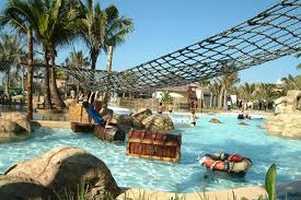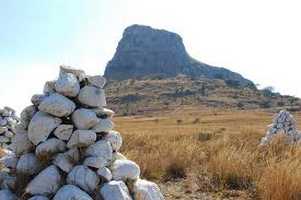Quick Facts: KwaZulu-Natal
- Capital of KwaZulu-Natal: Pietermaritzburg
- Major city: Durban
- Languages: 80.9% isiZulu, 73.6% English, 1.5% Afrikaans
- Population: 9 904 698 (2006)
- Share of South Africa’s population: 20.9%
- Area: 94 361 square kilometres
- Share of total South Africa’s area: 7.7%
- Population density: 105 people per square kilometre
- Gross regional product: R 206.8-billion
- Share of total South Africa’s GDP: 16.7%
Introducing KwaZulu-Natal
KwaZulu-Natal is often referred to as the garden province of South Africa. This magnificent region of South Africa is subtropical with lush and well-watered valleys and bordered by the warm Indian Ocean to the east. As one of South Africa’s most popular tourist destinations, KwaZulu-Natal stretches from Port Edward in the south to the borders of Swaziland and Mozambique in the north.
The western region of KwaZulu-Natal, South Africa, is marked by the dramatic Drakensberg mountain range with several peaks over 3 000 metres. The Drakensberg mountain range has been awarded World Heritage status for its dramatic natural beauty and the wealth of San Bushman rock art found in its caves, which is the richest concentration on the African continent. Between the mountains and the humid, subtropical coastline lies savannah grassland, but indigenous forest can be found along the coast of KwaZulu-Natal, South Africa . The largest of its many rivers is the Thukela.
KwaZulu-Natal is the only province in South Africa with a monarchy specifically provided for in South Africa's Constitution. The province's name comes from the Zulu kingdom of KwaZulu, previously a nominal homeland in the apartheid era, and the former British colony of Natal, later a province of South Africa.The city of Durban in KwaZulu-Natal, South Africa, is one of the fastest-growing urban areas in the world.
Its harbour is the busiest in South Africa and one of the 10 largest in the world. Every year the port of Durban handles over 30 million tons of cargo with a value of more than R100-billion. To the north of Durban, the port of Richards Bay, an important coal-export harbour, processes about 12 000 containers a year. Combined, the two ports (Durban and Richards Bay) make up about 78% of South Africa's cargo tonnage.
Major cities and towns of KwaZulu-Natal, South Africa
The capital of KwaZulu-Natal in South Africa is Pietermaritzburg, which is situated inland from Durban. KwaZulu-Natal is home to several popular coastal holiday resorts, such as Port Shepstone, Umhlanga Rocks and Margate. Inland, there are smaller cities and towns such as Newcastle, which is well-known for its steel production and coal-mining, Estcourt for meat processing, and Ladysmith and Richmond for mixed agriculture. The KwaZulu-Natal coastal belt yields sugar cane, wood, oranges, bananas, mangoes and other tropical fruit.
Climate of KwaZulu-Natal
KwaZulu-Natal in South Africa is a summer rainfall area, with a climate that ranges from extremely hot along the coast during the summer months to heavy snow on the mountains in winter. The Midlands in KwaZulu-Natal are drier than the coast and can be very cold in the winter.
The size of KwaZulu-Natal, South Africa
Covering an area of 94 361 square kilometres, KwaZulu-Natal in South Africa is roughly the size of Portugal. Being the country's third-smallest province, taking up 7.7% of South Africa's land area, it has the largest population, approximately 9.9-million people.
Languages spoken in KwaZulu-Natal
The principal language in KwaZulu-Natal is isiZulu, followed by English and Afrikaans. Remnants of British colonialism and a mix of Zulu, Indian and Afrikaans traditions give this province a rich cultural diversity.
National Parks and nature reserves
KwaZulu-Natal has active conservation activities. The Royal Natal National Park is home to more than 1 000 plant species, 12 species of antelope and three of the world's seven species of crane. Other reserves are Giant's Castle and the Kamberg Nature Reserve. Champagne Castle is situated in the central region of KwaZulu-Natal's magnificent Drakensberg range of mountains.
Some of South Africa's best-protected indigenous coastal forests are found along the subtropical coastline of KwaZulu-Natal, such as at Dukuduku and Kosi Bay. It is also along this coast that the magnificent St Lucia Estuary and Kosi Bay lakes are located. With the Drakensberg, the Greater St Lucia Wetlands Park is one of KwaZulu-Natal's two Unesco World Heritages sites. The northern part of the province, on the Swaziland border, is typical African savanna, providing a natural backdrop for its rich wildlife, protected in several game parks.
KwaZulu-Natal’s industry
Richards Bay in South Africa is the centre of operations for the country’s aluminium industry. The Richards Bay Coal Terminal is instrumental in securing South Africa’s position as the second-largest exporter of steam coal in the world. ‘Richards Bay Minerals’ is the largest sand-mining and mineral-processing operation in the world.
The vehicle-manufacturing industry has created a considerable multiplier effect in component- and service-providers. The automotive leather industry has grown rapidly, with exports significantly increasing foreign exchange earnings.
The province of KwaZulu-Natal has also recently undergone rapid industrialisation, thanks to its abundant water supply and labour resources. Industries are situated in Newcastle, Ladysmith, Dundee, Richards Bay, Durban, Hammarsdale, Richmond, Pietermaritzburg and Mandeni.
Substantial progress has been made to the Dube Trade Port and King Shaka International Airport project at La Mercy. It is estimated that redevelopment of the current airport site will create 269 200 jobs over a 25-year period.
Agriculture in KwaZulu-Natal, South Africa
The fertility of the soil and comparatively good rainfall in this region of South Africa, more than 1 000 mm a year, make agriculture central to the economy of KwaZulu-Natal.
The sugar-cane plantations along the Indian Ocean are the mainstay of KwaZulu-Natal's agriculture. The coastal belt is also a large producer of subtropical fruit, while the farmers in the inland concentrate on vegetable, dairy and stock-farming. Another major source of income is forestry, in the areas around Vryheid, Eshowe, Richmond, Harding and Ngome. Ngome also has tea plantations.

.jpg)


.jpg)
.jpg)
.jpg)
.jpg)
.jpg)


.jpg)
.jpg)
.jpg)
.jpg)